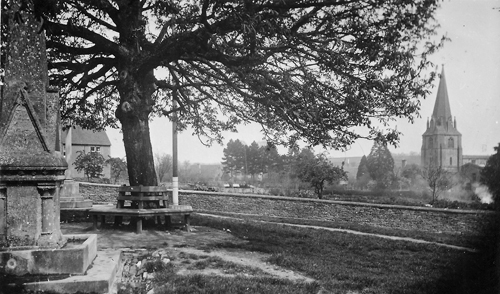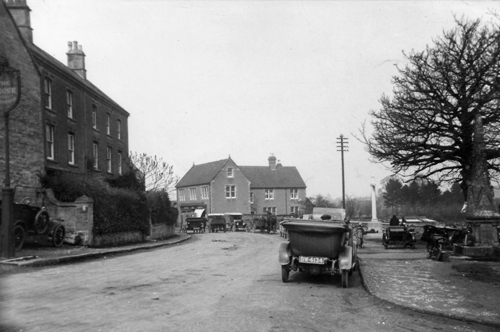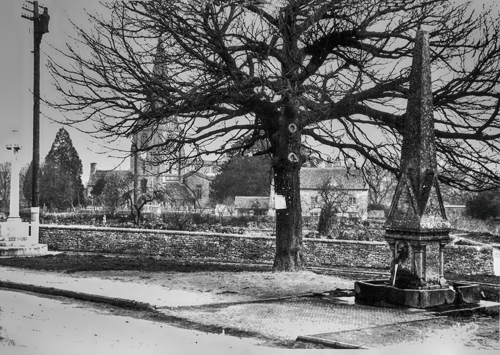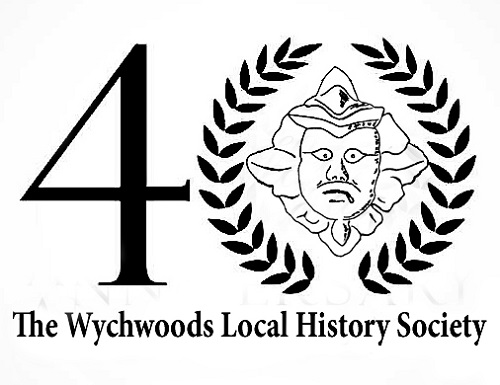
Here is an article by Margaret Ware, taken from the WLHS Journal No 14 (1999). We republish it here as part of an occasional series celebrating the work of the Society over time. (A PDF of the Society’s Journal No 14 can be found here).
A separate PDF of the article is available here.
The Cospatrick Tragedy: Memorial
Shipton Church from Cospatrick memorial. Estimated 1920s
High Street Shipton 1920s, with Cospatrick Memorial
On the village green at Shipton under Wychwood, next to the war memorial, stands a stone drinking fountain with a distinctive tall, conical spire. It was erected in 1878 in memory of the seventeen members of the Hedges and Townsend families from Shipton who lost their lives in the South Atlantic in a fire on the emigrant sailing ship, the Cospatrick, bound for New Zealand.
The brass plaque on the north side lists Richard Hedges aged 56, Sarah his wife (53); John Hedges (24) and Sarah his wife (22); Thomas Hedges (27), Charles Hedges (18) both sons of Richard and Sarah. That on the south lists Henry Townsend aged 62, Ann his wife (53); George Charter (31), Jane Townsend his wife (35) and their two children; Henry Hedges (30) and Mary Townsend his wife (30) and their three children. All the men were agricultural labourers.
Photograph from a postcard of The Green, showing allotments bordered by a wall. There is no seat around the tree at this date. Also photo taken pre-metal plates on the Cospatrick Memorial. Date: c. late 1920s
The Cospatrick Tragedy: Background
19th Century Emigration from Oxfordshire: See Our Book Review
In late Victorian England many agricultural workers and their families led desperately hard lives. They laboured by hand for long hours in harsh conditions for low wages, earning on average only half as much as industrial workers. Rural tied housing was often poor and insanitary, with no security of tenure. The country way of life was strictly regulated by the landlords and tenant farmers, the squire and the Church, with harsh administration of the Poor Law and of penalties for poaching. These conditions were made worse in the 1870s by a run of bad weather and poor harvests.
The early 1870s saw the newly formed National Agricultural Labourers Union beginning the fight for better wages and conditions, but many people emigrated to start a new life in Australia, New Zealand and Canada, a substantial number of these coming from Oxfordshire.
During this period the New Zealand government provided free passages to assist over 50,000 English people to emigrate, while the Agricultural Union and others set up funds to buy clothing and equipment for the long and arduous journey, with Union officials often acting as emigration agents.
The voyage under sail in an iron clipper usually took about fifteen weeks, although newly-commissioned steamers were completing it in half the time. Animals, chickens and geese were taken on board for food but seasickness and epidemics of scarlet fever, measles and typhoid took their toll and many people, especially children, died on the journey.
However once the survivors had arrived and settled in, they frequently sent back enthusiastic reports of their improved conditions and of the many attractions of the new country’.
Emigration rose to a peak in 1873 and 1874, and during this period at least 160 people are known to have left for New Zealand from Milton and Ascott, many to settle in the Hawke’s Bay area, but until the autumn of 1874 only three folk had ventured from Shipton. Then Richard Hedges and Henry Townsend with their wives and families joined 400 other emigrants and 44 crew on the Cospatrick which sailed from Blackwall Dock in London on 11 September bound for Auckland.
About the Cospatrick
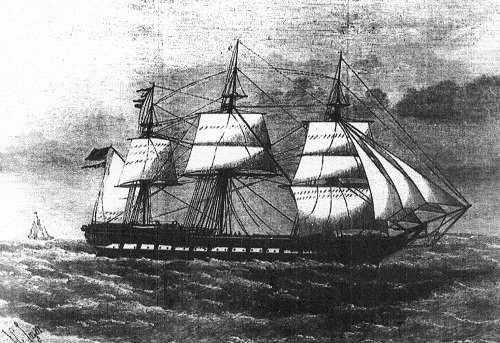
This engraving of the Cospatrick appeared in the Illustrated London News 19 January 1875. Reproduced with kind permission of Mr R R William
The Cospatrick was a two-decked, full-rigged wooden ship of about 1,200 tons, owned by Shaw Savill & Co, which had transported thousands of people during the previous nine years without incident. It had recently been inspected and pronounced sound. In addition to the passengers and their stores (which included coal for cooking and heating), it now carried iron rails and cement, and an inflammable cargo of linseed oil, turpentine and varnish, candles, rum, brandy, wine and beer. Fire precautions were strictly enforced, fires and lights being lit only by the cook and stewards while the emigrants themselves carried out fire-watch duty.
The Fire on the Cospatrick
Nevertheless fire broke out just after midnight on 17 November near the boatswain’s locker, and spread quickly. Panic ensued and most people died in the inferno or drowned when they jumped from the blazing ship, which sank after two days. Only two of the ship’s four lifeboats got away, laden with emigrants and crew. They were over 700 miles from the Cape of Good Hope and without food or drink, mast, sail or compass. After three days one boat drifted out of sight. The other was sighted by a passing ship after ten days but only four people, three of them crew members, were still alive. The remaining emigrant died after being rescued.
Aftermath of the Cospatrick Tragedy
This appalling tragedy shocked the nation. The Board of Trade enquiry later concluding that the fire probably started as a result of someone attempting to raid the liquor store. It was one of the worst maritime disasters of the century and probably contributed to the waning of interest in emigration thereafter. The steady drain of the labour force had also begun to concern farmers at home, and was providing a stronger bargaining position for the Agricultural Union to secure better wages and working conditions for its members, so there was now less incentive to leave.
In 1877 a committee in Shipton under Wychwood raised £70 towards a memorial to the local victims of the disaster and the fountain was erected on the green a year later. As time passed the carved stone lettering-weathered and faded, and brass plates bearing the original inscriptions were fixed on the north, south and west sides on 17 November 1934, the sixtieth anniversary of the tragedy. A fourth brass was also added, on the east side, recalling the original tragedy, and to commemmorate the coronation of King Edward VII in 1901.
The inscription on the west side reads:
Whosoever drinketh of this water shall thirst again but whosoever drinketh of the water that I shall give him shall never thirst.
John, Ch. IV v. 13 and 14
Bibliography
Rollo Arnold, The Farthest Promised Land, Victoria University Press, Wellington, New Zealand 1981. Dr Arnold portrays the national picture of emigration to New Zealand and the role of the infant trade unions.
R.R. Williams, The Survival of Twin Pen-Stryd, Cymgen (Wales), Anglesey 1975. The story of the disaster and the amazing survival of Able Seaman Thomas Lewis of Anglesey.
Wychwoods History No. 3,1987, pp45-52 gives an account of the social and agricultural conditions of the time. See the article here, or download as a PDF here.

